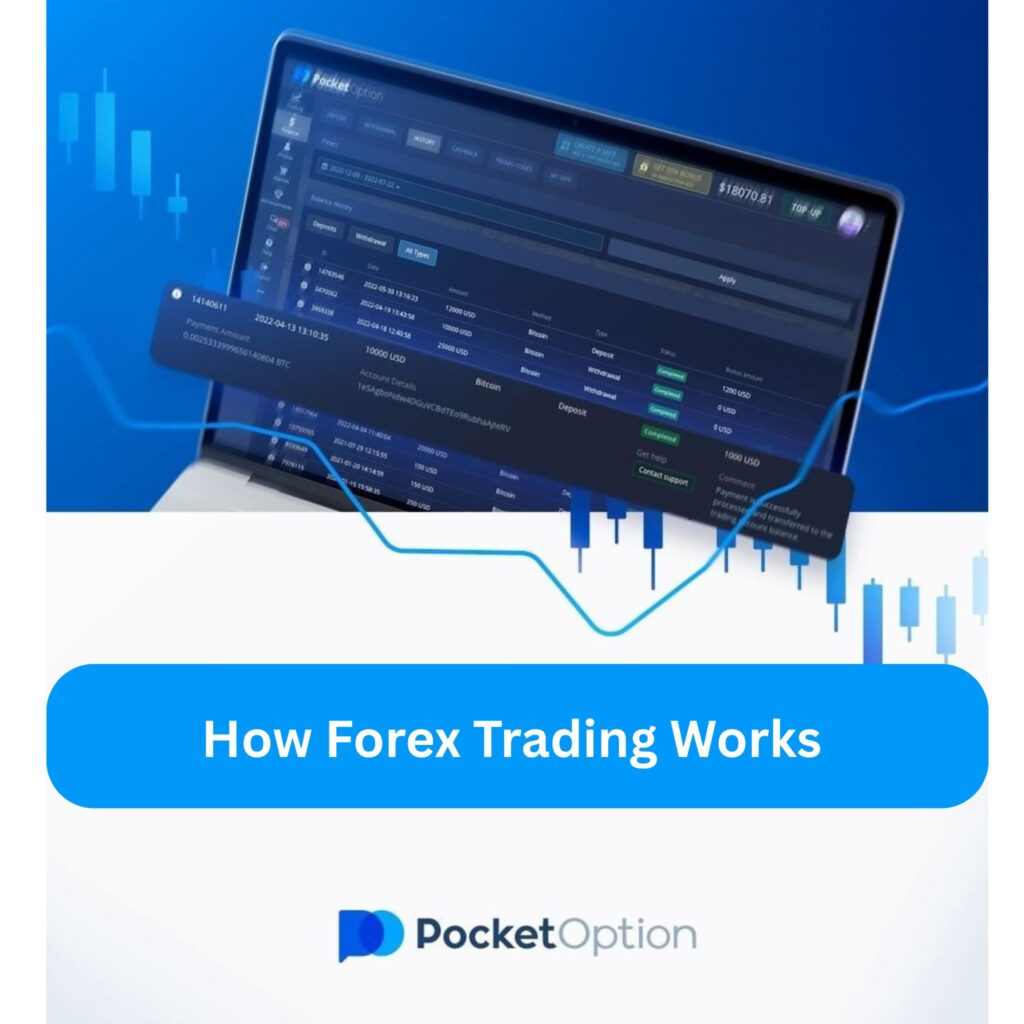Forex Trading on Pocket Option
The foreign exchange market, or Forex, is one of the largest and most active financial markets in the world. At Pocket Option, you can trade a wide range of currency pairs directly on an easy-to-use platform. Whether you’re new to Forex or an experienced trader, you’ll find the tools and features you need to explore market opportunities and manage your trades with confidence.
Why Trade Forex on Pocket Option?
Pocket Option makes Forex trading simple and accessible for everyone. Here’s why many traders choose this platform for trading currency pairs:
The trading platform is designed to be easy to navigate, whether you’re on a computer or mobile device. Placing trades, analyzing charts, and managing your account is straightforward.
Trade major pairs like EUR/USD, minor pairs, and even exotic options, giving you flexibility to explore different markets.
Enjoy quick order processing, which helps ensure that your trades are executed at the price you see.
Use built-in technical indicators, signals, and charting tools to help with market analysis and decision-making.
Start trading with small amounts, making Forex accessible even if you’re new or want to test strategies without large investments.
Access guides, tutorials, and demo accounts to improve your skills and practice strategies without risking real money.
These features make Pocket Option a convenient choice for anyone looking to explore the Forex market, from beginners to experienced traders.
Content Overview Forex Trading on Pocket Option
- Why Trade Forex on Pocket Option?
- How Forex Trading Works on Pocket Option
- Forex Instruments Available on Pocket Option
- Pocket Option Trading Features and Tools
- Steps to Start Forex Trading on Pocket Option
- Risk Management in Forex Trading Pocket Option
- Common Questions About Forex Trading on Pocket Option
How Forex Trading Works on Pocket Option
Forex trading is the process of buying one currency while selling another at the same time. Currencies are always traded in pairs, like EUR/USD (Euro/US Dollar) or GBP/JPY (British Pound/Japanese Yen). The first currency in the pair is called the base currency, and the second is the quote currency.
The goal in Forex trading is to profit from changes in exchange rates. Here’s how it works:
- If you think the base currency (EUR) will rise against the quote currency (USD), you open a buy (long) position.
- If you believe the base currency will fall against the quote currency, you open a sell (short) position.
For example:
- If you buy EUR/USD and the euro increases in value compared to the dollar, you can sell later at a higher price and make a profit.
- If the euro drops in value, you could face a loss if you close the trade at a lower price.

Leverage in Forex Trading
Pocket Option offers leverage, which allows you to control a larger trade size with a smaller amount of your own money. For instance, with 1:100 leverage, you can control $10,000 in the market with just $100. This can increase potential profits but also increases risk, so it should be used carefully.
Price Movements
Prices in Forex are influenced by many factors like economic news, interest rates, geopolitical events, and market sentiment. Traders use technical analysis (charts, indicators) and fundamental analysis (news, reports) to predict price changes.
Forex Instruments Available on Pocket Option
Pocket Option provides a variety of currency pairs to trade, allowing you to access different parts of the global Forex market. These pairs are divided into three main categories:
Major Pairs
These include the most traded currencies in the world, featuring the US dollar and other major economies.
- EUR/USD (Euro / US Dollar)
- GBP/USD (British Pound / US Dollar)
- USD/JPY (US Dollar / Japanese Yen)
- USD/CHF (US Dollar / Swiss Franc)
- AUD/USD (Australian Dollar / US Dollar)
- USD/CAD (US Dollar / Canadian Dollar)
- NZD/USD (New Zealand Dollar / US Dollar)
Minor Pairs
These pairs do not include the US dollar but combine other major global currencies.
- EUR/GBP (Euro / British Pound)
- EUR/JPY (Euro / Japanese Yen)
- GBP/JPY (British Pound / Japanese Yen)
- AUD/JPY (Australian Dollar / Japanese Yen)
Exotic Pairs
These pairs combine a major currency with a currency from a smaller or emerging economy.
- USD/TRY (US Dollar / Turkish Lira)
- USD/ZAR (US Dollar / South African Rand)
- EUR/TRY (Euro / Turkish Lira)
The exact list of pairs available on Pocket Option may vary. You can check the platform for the full list.
Pocket Option Trading Times and Market Sessions
The Forex market is open 24 hours a day, five days a week, allowing for flexible trading opportunities. It operates across four major trading sessions:
- Sydney Session: Opens around 10 PM GMT
- Tokyo Session: Opens around 12 AM GMT
- London Session: Opens around 8 AM GMT
- New York Session: Opens around 1 PM GMT
These sessions overlap at certain times, creating periods of higher trading volume and volatility, especially during the London/New York overlap.
Pocket Option Trading Features and Tools
Pocket Option provides a variety of built-in tools designed to help traders make informed decisions while trading Forex. These tools are easy to access and can enhance your trading strategies by offering real-time data and analysis.
Technical Indicators
Technical indicators help analyze price trends, market momentum, and potential reversal points. Pocket Option offers popular indicators such as:
- Moving Averages (MA): Smooths out price data to identify trends.
- Relative Strength Index (RSI): Measures the strength of recent price movements to identify overbought or oversold conditions.
- Bollinger Bands: Helps visualize price volatility and potential breakout levels.
- MACD (Moving Average Convergence Divergence): Shows trend direction and momentum.
These indicators can be customized and added to your charts to assist with decision-making.
Charting Tools
Pocket Option includes interactive charts that allow you to track price movements across different timeframes, from one minute to one day or more. You can:
- Switch between chart types, such as candlestick, line, or bar charts.
- Draw trend lines, support and resistance levels, and other patterns directly on the chart.
- Zoom in or out to analyze short-term and long-term trends.
These features make it easier to visualize market behavior and apply your trading strategies effectively.
Trading Signals
Trading signals are suggestions based on market analysis, indicating potential buy or sell opportunities. Pocket Option provides signals that:
- Highlight possible entry or exit points based on technical setups.
- Cover various assets, including Forex pairs.
- Help traders who prefer a more guided approach.
These signals can be used alongside your own analysis to support trading decisions.
By combining these tools—indicators, charting features, and signals—you can build and refine your Forex trading strategies directly on Pocket Option’s platform without needing third-party software.
Steps to Start Forex Trading on Pocket Option
Getting started with Forex trading on Pocket Option is simple and straightforward.
Follow these easy steps to begin your trading journey:
- Create an Account
Sign up on the Pocket Option website or app using your email, Google, or Facebook. - Verify Your Identity (KYC)
Complete the verification process by uploading your ID and proof of address to ensure secure withdrawals. - Deposit Funds
Go to the deposit section, choose a payment method like a bank card or crypto, and add funds to your trading account. - Pick a Currency Pair and Trade
Select a Forex pair such as EUR/USD, use the built-in tools for analysis, and open your first trade.
That’s it! You’re now ready to trade Forex on Pocket Option. You can practice with a demo account first or start trading with real funds when you’re ready.

Risk Management in Forex Trading Pocket Option
| Risk Management Stratege | Description |
| Use Stop-Loss Orders | Automatically closes a trade at a set loss level to prevent bigger losses. |
| Set Take-Profit Levels | Locks in profits by closing a trade when it reaches a certain profit target. |
| Manage Leverage Wisely | Avoid using high leverage to reduce the risk of large losses from small market moves. |
| Diversify Trades | Trade different currency pairs or assets to spread risk and avoid overexposure. |
| Never Risk More Than You Can Afford to Lose | Only invest funds that you are prepared to lose without affecting your financial stability. |
| Use a Risk/Reward Ratio | Plan trades with a favorable ratio between potential profit and possible loss (e.g., 2:1). |
| Stay Updated on Market News | Keep an eye on economic news and events that may impact the Forex market. |
Common Questions About Forex Trading on Pocket Option
What is the minimum amount needed to start Forex trading?
You can start Forex trading on Pocket Option with as little as $1 per trade, making it accessible even for beginners.
Does Pocket Option offer leverage for Forex trading?
Yes, Pocket Option provides leverage, allowing you to control larger positions with a smaller deposit. Be cautious, though—while leverage can increase potential profits, it also increases risk.
Can I practice Forex trading without risking real money?
Absolutely! Pocket Option offers a demo account with virtual funds, so you can practice trading strategies and get comfortable with the platform before investing real money.
What currency pairs are available for trading?
You can trade a wide variety of major, minor, and exotic currency pairs, including popular options like EUR/USD, GBP/JPY, and USD/TRY. The full list is available in the trading terminal.
Are there any fees for Forex trading?
Pocket Option doesn’t charge a commission for opening trades, but spreads (the difference between the buying and selling price) apply to each trade.
When can I trade Forex on Pocket Option?
Forex trading is available 24 hours a day, five days a week, covering all major global trading sessions (London, New York, Tokyo, Sydney).
How can I manage risk while trading Forex?
You can use tools like stop-loss and take-profit orders to manage risk. Additionally, practicing good money management, like limiting leverage and setting a risk/reward ratio, helps protect your funds.
